Q: Greg, reading through some of your old columns online I came across one about Cadillac innovation over the years. It sparked a memory of mine that the Stuart (Stewie) tanks made here in my hometown of Berwick, Pa., and used engines manufactured by Cadillac. Can you provide any further information about this WWII effort? Thank you. Signed “Brash-Brash” – from Berwick, Pa.
A: I’m happy to oblige.
Back in 2016 or 2017, I saw a Stuart tank at the Bloomsburg Fair in Bloomsburg, Pa. When I mentioned that a Cadillac engine probably powered the tank, a bystander overheard my remark and told my group that the tank was built in nearby Berwick, Pa. This gentleman certainly knew his tanks and just about everything else that the car manufacturers did in that important era.
To better answer your question, from early 1940 through April of 1944, the American Car & Foundry (ACF) company in Berwick, Pa., known for building top quality railroad passenger cars, produced 15,224 Stuart Light Tanks for the United States Army, Marines, and the Lend-Lease Program for our Allies. The tank models included the M2A4, M3, M3A1, M3A3, and the M5A1.
Thanks to the Berwick Historical Society, I was able to uncover some interesting history. Specifically, the ACF’s Stuart Tank is not only a significant part of the history of Berwick; it played a momentous role in United States and world history. Particularly, the Stuart Tank was the first U.S. Tank designed to function independently with a top speed of 35-mph, as previous tanks were designed only for infantry support with a top speed of just 10-mph.

Cadillac was very aggressive with its war era advertising, letting the public know its engines were powering many combat tanks. General Motors had the most military contracts overall, and produced a long line of military hardware. (Compliments Cadillac)
The Berwick built M2A4 is also the first military tank ever built on an assembly line, as previous U.S. built tanks were individually fabricated at Arsenals across the nation. Notably, all Allied armies in every War Theatre including North Africa, Europe, Asia, Pacific, and also Alaska and Antarctica utilized Stuart tanks.
Further, Stuart light tanks were the first to ever be taken into actual combat in WWII. As for the Cadillac engines, Stuart tanks were powered by twin V-8 Cadillac water-cooled engines, notably in the M5 and M5A1. They produced 110-horsepower each and came in at a size of 346 cubic inches. Back then this was big power.
Additionally, Berwick was the biggest manufacturer of armor plate, producing nearly 10% of all armor for the U.S. Military at its most critical time of need. Every armored vehicle produced for World War II efforts utilized at least some of the Berwick produced armor, while one of every eight armored vehicles used in World War II was built at ACF in Berwick.
Even Adolph Hitler himself selected the ACF in Berwick as one of his top 19 bombing targets known as “Hitler’s Amerika Bomber” exercise. Luckily, he did not succeed.

This photo, compliments of the U.S. Army, shows one of two 346 cubic inch Cadillac V8 engines being lowered into a tank. The engines produced 110-horsepower each allowing the tanks to drive at an unheard of speed of 35-MPH from the final 220-horses. (U.S. Army photo)
At its peak, ACF of Berwick employed 9,135 workers from 177 municipalities in northeastern Pennsylvania. At peak production, Stuart Light Tanks were being produced by the Berwick workforce at a rate of 40 per day. This was in addition to the millions of artillery shells, hundreds of railroad cars and other miscellaneous items produced at the plant.
Following completion of the 15,224th Stuart Tank, ACF – Berwick was contracted to produce 10,000 D7 US Army bulldozers, 150 M37 105mm Gun Carriages, 1,050 suspension sets for British-built tanks, 105,000 tons of armor plate, finish work on 1,000 pound bombs, 400 kitchen rail cars, 63 power trains, 3,000 gondolas, tenders and hoppers, and 480 caboose cars. ACF closed in December of 1961 but the complex is still active today with many businesses sharing space. Several of the original buildings still exist, although most have been remodeled.
In 2017, a reunion was held in Berwick celebrating the company’s history, and the centerpiece of the event was a Stuart Tank named “Lady Lois,” built in December 1942. Tom McLaughlin, secretary of the Stuart Tank Memorial Association Committee, brought the tank “back home” and the town had a big party in honor of those who built and manned it in combat. Local and national print, radio and television media covered the event.
Further, and to give credit to all car manufacturers, domestic passenger automobile production was halted by government order in February of 1942 and everyone concentrated on war supply needs. These car companies received over $10-billion in war-related orders after the bombing of Pearl Harbor in ’41 compared to just $4-billion before the Pearl Harbor attack.

Pictured is another war era advertisement from Cadillac. When the war was over, they used many of the leftover 346 flathead V8s in their automobiles. (Compliments Cadillac)
During this time, manufacturer’s either enlarged and/or converted factories. Henry Ford II, however, built a new airplane specific factory at Willow Run, Michigan, while Chrysler constructed its Detroit Arsenal Tank plant.
In total, these car and war specific plants produced 5.9-million weapons, 2.8-million tanks and trucks and 27,000 aircraft, the latter of which Ford accounted for near 9,000 alone at its B-24 Bomber plant in Willow Run. Back then Henry Ford’s employees, mostly women, could build a B-24 ready to fly in less than an hour.
Ford so impressed everyone involved with his B-24 Bomber feat, it is important to note that this success took place before the Dec. 7, 1941 Pearl Harbor attacks, proving our administration knew our country was going to need some serious air power based solely on rumors of war and the necessity to address the Nazi world dominance concerns. Ditto the Berwick tank workforce where they produced tanks daily before the initial harbor attack.
Although I’ve given special attention to the Berwick Tank building efforts, I also want to acknowledge the other manufacturers that played a huge role.

The very last tank produced in Berwick, Pa., number 15,224 built on April 17, 1944. (Compliments Berwick Historical Society)
General Motors was involved with all of its brands in producing armaments, vehicles and aircraft, and had more contracts than any other company. Its Cadillac engines were perhaps most noteworthy as they powered the Stuarts; Dodge division of Chrysler was best known for its heavy duty military trucks and ambulances; Packard built PT Boat and airplane engines, and its V-1650 engine powered the famous P-51 Mustang fighter plane; Studebaker produced a US6 truck and the novel M29 Weasel cargo and personnel carriers; Checker, the famous taxi cab manufacturer, built tank retrieval trailers and tank recovery vehicles; Hudson constructed aircraft parts, anti-aircraft guns and naval engines and is perhaps best known for its “Hudson Invader” engine, which powered many of the landing watercraft on D-Day at Normandy, June 6 of 1944; Nash – Kelvinator assembled military specific supplies and appliances; Henry Kaiser, soon of Kaiser-Frazer auto fame, became legendary for his California shipyard where his workforce put together the “Liberty” and “Victory” cargo ships in record time; Willys and Ford shared Jeep production from 1941 through 1945, and today’s modern Jeep Wrangler is a tribute to this unique design.
In ending, much praise goes to all of our auto manufacturers and the dedication of our military and civilian “everyday worker” men and women for winning the war via outstanding assembly efforts. Thanks “BB” for the question about Berwick tanks and those flathead V8 Cadillac engines.
(Greg Zyla is a syndicated auto columnist who welcomes questions on auto nostalgia, collector cars and motorsports at greg@gregzyla.com.)



Be the first to comment on "Cars We Remember; Cadillac engines and Berwick, Pa. played major role in World War II tank success"